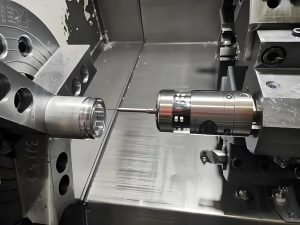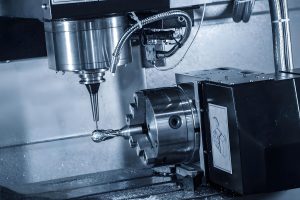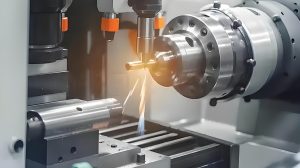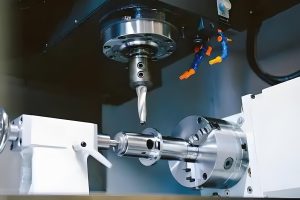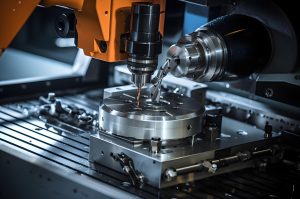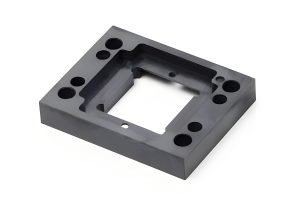Introduction
Definition and basic principle of CNC milling machines
CNC milling machines, short for Computer Numerical Control milling machines, are advanced and automated machine tools that play a pivotal role in modern manufacturing processes. These machines are designed to remove material from a workpiece in a highly precise and controlled manner, using a variety of cutting tools.
The basic principle of a CNC milling machine is centered around the concept of numerical control. Instead of being manually operated, the machine is guided by a set of pre-programmed instructions. These instructions are typically created using computer-aided design (CAD) and computer-aided manufacturing (CAM) software. The CAD software is used to design the 3D model of the part to be produced. Then, the CAM software takes this design and generates the necessary toolpaths and commands for the CNC milling machine.
Once the program is loaded into the machine’s control system, the CNC milling machine can start its operation. The machine’s spindle rotates the cutting tool at high speeds, while the workpiece is moved along multiple axes (usually three or more) in a coordinated manner according to the programmed instructions. This precise movement of the tool and the workpiece allows for the creation of complex shapes and geometries with high accuracy.
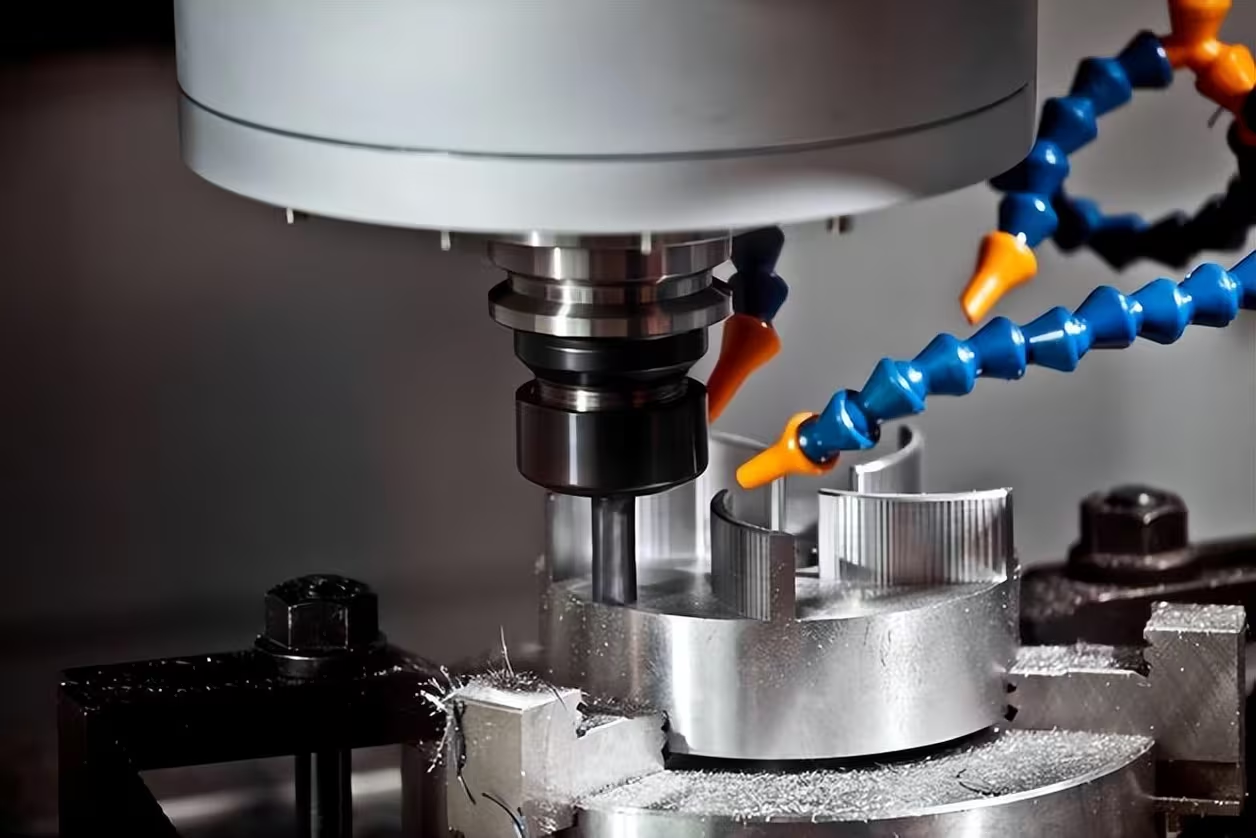
Significance in modern manufacturing
In modern manufacturing, the significance of CNC milling machines cannot be overstated. They have revolutionized the way products are made, enabling manufacturers to achieve levels of precision and efficiency that were previously unattainable.
One of the key advantages of CNC milling machines is their high precision. They can consistently produce parts with tight tolerances, often within a few thousandths of an inch. This level of accuracy is crucial in industries such as aerospace, automotive, and medical device manufacturing, where even the slightest deviation can have significant consequences. For example, in the aerospace industry, components for aircraft engines need to be manufactured with extreme precision to ensure optimal performance and safety. CNC milling machines can meet these stringent requirements, allowing for the production of high-quality parts that contribute to the overall reliability and efficiency of the aircraft.
In addition to precision, CNC milling machines also offer high efficiency. They can operate continuously for long periods without the need for frequent breaks or adjustments, unlike manual milling machines. This allows for increased productivity and shorter production cycles. With the ability to automate the machining process, CNC milling machines can also reduce the need for manual labor, minimizing the risk of human error and improving overall quality control.
Moreover, CNC milling machines are highly versatile. They can be used to machine a wide range of materials, including metals, plastics, and composites. This makes them suitable for a variety of applications, from prototyping to large-scale production. Whether it’s creating a complex prototype for a new product or manufacturing thousands of identical parts for mass production, CNC milling machines can handle the task with ease.
Overall, CNC milling machines have become an essential tool in modern manufacturing. Their ability to provide high precision, efficiency, and versatility has made them indispensable in a wide range of industries, driving innovation and progress in product design and production. As technology continues to advance, we can expect CNC milling machines to become even more sophisticated and capable, further enhancing their role in the manufacturing landscape.
The Working Mechanism of CNC Milling Machines
Key components
- Bed: The bed is the foundation of a CNC milling machine. It is typically made of high – quality cast iron or steel, which provides excellent stability and vibration dampening. Its primary function is to support all the other components of the machine, ensuring that they remain in the correct position during operation. A stable bed is crucial for achieving high – precision machining, as any movement or vibration can lead to inaccuracies in the final product. For example, in the production of aerospace components, where tolerances are extremely tight, a rigid and stable bed is essential to ensure that the milling operations are carried out with the required precision.
- Worktable: The worktable is where the workpiece is mounted. It can move along different axes (usually the X, Y, and Z axes in a three – axis milling machine) according to the programmed instructions. The worktable is equipped with precision – guided rails, which allow for smooth and accurate movement. Some worktables also have the ability to rotate, adding an additional degree of freedom to the machining process. This is particularly useful when creating complex parts with angled features or when multiple operations need to be performed on different sides of the workpiece. For instance, in the manufacturing of molds for plastic injection, the worktable’s ability to rotate can enable the creation of intricate 3D shapes.
- Spindle: The spindle is the component that holds and rotates the cutting tool. It is driven by a powerful motor, which can rotate the tool at high speeds, typically ranging from a few hundred to tens of thousands of revolutions per minute (RPM). The spindle’s speed can be precisely controlled according to the requirements of the machining operation. High – speed spindles are often used for machining soft materials like aluminum, as they can increase the material removal rate and improve surface finish. On the other hand, for harder materials such as steel, a lower spindle speed may be required to ensure the tool life and machining accuracy. The spindle also needs to have high – precision bearings to maintain the concentricity of the cutting tool, which is vital for achieving accurate cuts.
- Control system: The control system is the brain of the CNC milling machine. It consists of a computer – based unit that reads and interprets the pre – programmed instructions. This system controls the movement of the worktable, the rotation speed of the spindle, and the operation of other components such as the coolant system. Modern control systems are highly advanced, with features like touch – screen interfaces, which make it easier for operators to input commands and monitor the machining process. They also often have built – in diagnostic functions, which can detect and report any malfunctions or errors in the machine, helping to minimize downtime and improve productivity. For example, if there is a problem with the spindle speed or the movement of the worktable, the control system can quickly identify the issue and provide an error message to the operator.
How it operates
- Programming the machine: The first step in operating a CNC milling machine is to create a program. This is usually done using CAD/CAM software. The CAD software is used to design the 3D model of the part to be machined. Once the design is complete, the CAM software takes this model and generates the toolpaths. The toolpaths are a set of instructions that tell the CNC milling machine how to move the cutting tool relative to the workpiece to achieve the desired shape. These instructions include details such as the starting and ending positions of the tool, the feed rate (how fast the tool moves along the path), and the spindle speed. For example, if you are creating a complex part with multiple curves and holes, the CAM software will calculate the optimal toolpaths to machine these features accurately.
- Loading the program: After the program is created, it is loaded into the CNC milling machine’s control system. This can be done through a variety of methods, such as using a USB drive, an Ethernet connection, or a direct – connect cable. Once the program is loaded, the operator can review and verify the settings, such as the tool selection, spindle speed, and feed rate.
- Machine operation: Once the program is loaded and the settings are verified, the operator can start the machining process. The control system reads the program instructions and sends signals to the various components of the machine. The spindle starts to rotate the cutting tool at the specified speed, while the worktable moves the workpiece along the programmed toolpaths. The cutting tool removes material from the workpiece as it moves, gradually shaping it into the desired form. During the operation, the machine can also automatically change tools if required, thanks to the tool – changing mechanism. This allows for multiple operations to be performed on the same workpiece without the need for manual intervention. For example, a single part may require drilling, milling, and tapping operations. The CNC milling machine can perform all these operations in sequence by automatically changing the appropriate cutting tools.
- Monitoring and adjustment: While the machine is operating, the operator needs to monitor the process. This can be done through the control system’s display, which shows real – time information such as the position of the worktable, the spindle speed, and the progress of the machining operation. If any issues are detected, such as an abnormal noise, vibration, or a deviation from the programmed dimensions, the operator can pause the machine and make adjustments. These adjustments may include changing the cutting parameters, such as the feed rate or spindle speed, or checking and replacing the cutting tool if it is worn out.
Features and Advantages of CNC Milling Machines
High precision
CNC milling machines are renowned for their exceptional precision. They can achieve tolerances as tight as ±0.001 inches or even better in some advanced models. This high level of accuracy is crucial in many industries. For example, in the aerospace industry, components such as turbine blades for jet engines require extremely precise manufacturing. These blades must be machined to exact specifications to ensure efficient combustion, optimal engine performance, and safe operation. A deviation of just a few thousandths of an inch in the shape or dimensions of a turbine blade can lead to significant inefficiencies, increased fuel consumption, and potentially dangerous situations during flight.
Another example is the production of medical implants. Hip replacements, for instance, need to be precisely machined to fit the patient’s anatomy perfectly. The CNC milling process can create implants with smooth surfaces and accurate dimensions, ensuring a proper fit within the patient’s body. This not only improves the success rate of the implantation but also reduces the risk of complications such as implant rejection or misalignment.
Efficiency
When compared to traditional milling methods, CNC milling machines offer a significant boost in efficiency. One of the key factors contributing to this is their ability to perform automated operations. In traditional milling, the operator has to manually adjust the machine settings for each operation, which is time – consuming. With CNC milling, once the program is set up, the machine can run continuously, performing multiple operations in sequence without the need for constant human intervention.
Automated tool – changing systems are a prime example of how CNC milling machines enhance efficiency. These systems can change cutting tools in a matter of seconds. In a typical machining operation that requires multiple types of cuts, such as milling, drilling, and tapping, a CNC milling machine can quickly switch between different tools. This reduces the time wasted on tool changes, which could be several minutes in a manual setup. For example, in the production of automotive engine blocks, which require numerous holes to be drilled and tapped, as well as complex surfaces to be milled, a CNC milling machine can complete these operations much faster than a traditional milling machine.
Moreover, CNC milling machines can operate continuously for long periods. They can run overnight or during weekends with proper monitoring, enabling manufacturers to increase their production output without a proportional increase in labor costs. This continuous operation also reduces the overall production cycle time, allowing companies to bring products to market more quickly.
Flexibility
CNC milling machines are highly versatile and can work with a wide range of materials. Metals like aluminum, steel, titanium, and copper are commonly machined on CNC milling machines. Aluminum, for example, is widely used in the aerospace and automotive industries due to its lightweight and high – strength properties. CNC milling machines can easily shape aluminum into complex parts, such as aircraft wing components or automotive engine parts. Steel, on the other hand, is used for applications that require high strength and durability, like machinery parts and structural components. The CNC milling process can handle the hardness of steel and create precise parts.
In addition to metals, CNC milling machines can also work with non – metallic materials. Plastics are frequently used in the production of consumer products, medical devices, and electronics. CNC milling can create intricate plastic parts with high precision. Composites, which are made up of two or more materials with different properties, are also becoming increasingly popular in industries such as aerospace and sports equipment manufacturing. CNC milling machines can accurately machine composite materials, taking into account their unique characteristics.
The flexibility of CNC milling machines also extends to the shapes they can create. They can produce parts with complex geometries, including curved surfaces, undercuts, and internal cavities. For example, in the mold – making industry, molds for plastic injection or die – casting often have intricate 3D shapes. CNC milling machines can precisely machine these molds, ensuring that the final products produced using these molds have the desired shape and quality. Whether it’s a small, detailed part for a watch or a large, complex component for a construction machine, CNC milling machines can handle the task with ease.
Rapidefficient’s Value in the CNC Machining Market
Innovation in technology
Rapidefficient stands out in the CNC machining market due to its continuous technological innovation. One of the remarkable aspects is its development of new machining algorithms. These algorithms are designed to optimize the toolpath in a more sophisticated way. For example, traditional algorithms may have limitations in handling complex geometries, leading to longer machining times and sub – optimal surface finishes. Rapidefficient’s new algorithms can analyze the 3D model of the workpiece in greater detail, taking into account factors such as the curvature of surfaces, the depth of cuts, and the material properties. This allows the CNC milling machine to move the cutting tool in the most efficient path, reducing the number of unnecessary movements and thus saving time.
In addition to machining algorithms, Rapidefficient has also made significant progress in intelligent control systems. Their intelligent control systems are equipped with advanced sensors that can monitor the machining process in real – time. These sensors can detect variables such as the cutting force, temperature, and vibration of the machine. If any abnormal conditions are detected, the control system can automatically adjust the machining parameters. For instance, if the cutting force exceeds a certain threshold, which may indicate that the cutting tool is wearing out or the machining process is not stable, the control system can reduce the feed rate or adjust the spindle speed to ensure the quality of the machining and prolong the tool life. This real – time monitoring and adjustment not only improve the quality of the products but also reduce the risk of machine breakdowns and costly rework.
Cost – effectiveness
Cost – effectiveness is a key value that Rapidefficient brings to the CNC machining market. Firstly, they have optimized their production processes. By streamlining the workflow from the initial design stage to the final machining, Rapidefficient can eliminate many inefficiencies. For example, in the design phase, their team uses advanced CAD/CAM software in a more integrated way. The CAD design is directly linked to the CAM programming, minimizing the need for manual intervention and reducing the chances of errors. This seamless integration reduces the time spent on design revisions and programming adjustments, which in turn shortens the overall production cycle.
Moreover, Rapidefficient focuses on improving the efficiency of its CNC milling machines. They invest in high – quality equipment and regularly maintain and upgrade it to ensure optimal performance. High – efficiency spindles and advanced servo – motor systems are installed in their machines, which can operate at higher speeds and with greater precision. This allows for faster material removal rates without sacrificing quality. For example, in the machining of aluminum parts, their machines can achieve a much higher feed rate compared to some traditional CNC milling machines, reducing the machining time for each part. With shorter production times and higher – quality outputs, Rapidefficient can offer more competitive prices to its customers, making their services more cost – effective.
Quality assurance
Rapidefficient places great emphasis on quality assurance in its CNC machining services. One of the key measures is its strict quality – inspection process. They have a team of experienced quality – control inspectors who are trained to use advanced inspection equipment. Before a workpiece is considered complete, it goes through multiple inspection steps. Coordinate measuring machines (CMMs) are used to measure the dimensions of the part with high precision. These CMMs can detect even the slightest deviation from the design specifications, ensuring that the final product meets the tight tolerances required by customers.
In addition to dimensional inspection, surface finish is also carefully evaluated. Rapidefficient uses optical profilometers to measure the surface roughness of the machined parts. A smooth surface finish is crucial for many applications, especially in industries like aerospace and medical device manufacturing. By closely monitoring and controlling the surface finish, Rapidefficient can ensure that their products perform optimally in their intended applications.
Furthermore, Rapidefficient has a comprehensive equipment – maintenance program. Regular maintenance of the CNC milling machines is carried out to keep them in top – working condition. This includes checking and replacing worn – out parts, calibrating the machine axes, and ensuring the proper functioning of the spindle and other components. Well – maintained machines are less likely to produce errors during the machining process, which is essential for maintaining high – quality production.
Applications of CNC Milling Machines
Aerospace industry
In the aerospace industry, the demand for precision and high – quality components is extremely high, and CNC milling machines play a crucial role. One of the key applications is in the manufacturing of engine blades. These blades are designed to withstand extreme temperatures and high – speed rotations within jet engines. The complex aerodynamic shapes of engine blades require precise machining to ensure optimal performance. CNC milling machines can accurately carve out the intricate curves and angles of the blades, achieving the tight tolerances necessary for efficient combustion and thrust generation. For example, a slight deviation in the shape of an engine blade can lead to a significant loss of engine efficiency, resulting in increased fuel consumption and reduced flight performance.
Another important application is in the production of the aircraft’s fuselage frame. The fuselage frame needs to be both lightweight and extremely strong to ensure the safety and efficiency of the aircraft during flight. CNC milling machines can machine the aluminum or titanium alloys used in the fuselage frame with high precision, creating complex structures that meet the strict requirements of the aerospace industry. These machines can accurately cut and shape the materials, ensuring a perfect fit between different components of the frame. This not only improves the overall strength of the fuselage but also reduces the weight, which is crucial for fuel – efficiency and flight range.
Automotive industry
In the automotive manufacturing sector, CNC milling machines are extensively used in the production of various components. Engine blocks are a prime example. Engine blocks house many of the engine’s moving parts and must be machined with high precision to ensure proper engine operation. The internal cavities and passages within the engine block, which are crucial for coolant flow and oil circulation, need to be accurately formed. CNC milling machines can precisely mill these complex internal structures, ensuring that the engine block has the right dimensions and smooth surfaces. This precision helps to improve engine performance, reduce friction, and increase the lifespan of the engine.
Transmission gears are another critical component in automobiles. These gears need to have precise tooth profiles to ensure smooth power transfer and efficient operation of the transmission system. CNC milling machines can manufacture transmission gears with high – accuracy, creating teeth that mesh perfectly with each other. The ability to produce gears with consistent quality and tight tolerances is essential for reducing gear noise, improving fuel efficiency, and enhancing the overall driving experience. Whether it’s for a high – performance sports car or a family sedan, the precision – made transmission gears by CNC milling machines contribute to the reliable operation of the vehicle.
Electronics industry
In the electronics industry, where miniaturization and high – precision are the norms, CNC milling machines are indispensable for manufacturing various components. Mobile phone cases are a common application. With the increasing demand for sleek and durable mobile phone designs, CNC milling machines can create intricate shapes and precise cutouts for buttons, ports, and camera lenses on the phone cases. For example, the thin and precise edges of a high – end mobile phone case are often achieved through CNC milling. This not only gives the phone a stylish appearance but also ensures a proper fit for internal components and external accessories.
Printed circuit boards (PCBs) are also commonly processed using CNC milling machines. PCBs are the backbone of electronic devices, and they require extremely precise manufacturing. CNC milling machines can accurately drill holes for component mounting and mill the circuit traces on the PCB. In the case of high – density PCBs with complex circuitry, the precision of CNC milling machines is crucial for ensuring the proper functioning of the electronic device. The ability to create fine – pitch traces and accurate holes allows for the integration of more components on a single PCB, contributing to the miniaturization and improved performance of electronic devices such as smartphones, tablets, and laptops.
Comparison with Other Machining Methods
Manual milling
Manual milling is a traditional machining method that relies heavily on the skills and experience of the operator. In manual milling, the operator directly controls the movement of the cutting tool and the workpiece by hand – turning wheels or using levers. This method has been used for a long time and has its own characteristics, but when compared with CNC milling, several significant differences emerge.
Precision: In manual milling, achieving high precision is extremely challenging. The operator’s physical strength and fatigue can affect the consistency of the machining process. For example, when making a series of cuts with the same depth and feed rate, a manual operator may experience slight variations due to hand – tremors or changes in muscle strength during the operation. Even a highly skilled operator may find it difficult to consistently maintain a tolerance of less than ±0.01 inches. In contrast, CNC milling machines can achieve tolerances as tight as ±0.001 inches or even better, ensuring the high – precision production of parts.
Efficiency: Manual milling is a time – consuming process. Each operation, such as changing the cutting tool, adjusting the feed rate, or moving the workpiece to a new position, requires the operator to perform manual actions. For instance, if a complex part requires multiple milling operations, the operator has to stop the machine, change the tool, and then carefully set up the next operation. This process can be very labor – intensive and time – consuming. In a CNC milling machine, once the program is set up, the machine can automatically perform multiple operations in sequence without the need for frequent manual intervention. It can work continuously for long periods, significantly increasing the production efficiency.
Labor intensity: Operating a manual milling machine is physically demanding for the operator. The operator has to constantly monitor the machining process, make adjustments, and handle heavy workpieces. This can lead to fatigue, especially during long – term operations. In a factory that uses manual milling for large – scale production, workers may experience high levels of physical stress, which can also increase the risk of errors. In contrast, CNC milling machines reduce the physical labor of the operator. The operator mainly focuses on programming, setting up the machine, and monitoring the overall process, rather than performing continuous manual operations.
Other CNC machining methods
- CNC lathes: CNC lathes are primarily designed for machining rotational parts. They work by rotating the workpiece while the cutting tool moves linearly or radially to remove material. One of the main differences between CNC lathes and CNC milling machines is the type of parts they are best suited for. CNC lathes are ideal for creating cylindrical parts, such as shafts, rods, and bushings. For example, in the automotive industry, the production of engine crankshafts is often carried out on CNC lathes. These parts have a cylindrical shape with various diameters and features along their length.
- In contrast, CNC milling machines are more versatile in creating complex 3D shapes. They can machine parts with irregular surfaces, multiple planes, and complex geometries. For instance, a CNC milling machine can create a mold with intricate cavities and protrusions, which would be very difficult to achieve on a CNC lathe. Another difference lies in the axis of movement. CNC lathes typically have two main axes (X and Z in a typical configuration), while CNC milling machines usually have three or more axes (X, Y, Z, and sometimes additional rotational axes like A, B, or C).
- CNC machining centers: CNC machining centers are a type of advanced CNC machine that combines multiple machining operations. They are similar to CNC milling machines but have some distinct features. One of the key differences is the presence of an automatic tool – changing system (ATC). Machining centers can automatically change tools during the machining process, which allows for a wider range of operations to be performed on a single workpiece without the need for manual tool changes.
- This is especially useful when a part requires a combination of milling, drilling, tapping, and other operations. For example, in the production of a complex aerospace component, a machining center can perform all these operations in one setup, reducing the overall production time and improving the accuracy by minimizing the need to re – position the workpiece. In contrast, while some CNC milling machines can also perform multiple operations, the tool – changing process may be more time – consuming or may require manual intervention. Additionally, machining centers often have larger work envelopes and higher – power spindles, making them suitable for heavy – duty machining of large and complex parts.
Tips for Choosing a CNC Milling Machine
Consider processing requirements
When choosing a CNC milling machine, the first and foremost factor to consider is your processing requirements.
Precision needs: If your work demands extremely high precision, such as in the aerospace or medical device industries, you should look for a machine with advanced servo – motor systems and high – precision ball screws. These components can ensure accurate movement of the axes, allowing the machine to achieve tight tolerances. For example, some high – end CNC milling machines can achieve a positioning accuracy of ±0.0001 inches. On the other hand, if your projects have relatively lower precision requirements, a mid – range machine with a positioning accuracy of ±0.001 – 0.005 inches may be sufficient, which can also save you some costs.
Material to be machined: Different materials have different hardness and machining characteristics. For soft materials like aluminum, a machine with a high – speed spindle (capable of reaching speeds of 10,000 – 30,000 RPM or even higher) can be very effective. It can increase the material removal rate and improve the surface finish. When it comes to harder materials such as steel or titanium, you need a machine with a more powerful spindle motor and a rigid structure to handle the high cutting forces. A machine with a spindle power of 5 – 15 kW may be suitable for general steel machining, while for titanium, a more powerful spindle and a well – designed cooling system are necessary to prevent overheating and tool wear.
Complexity of the part’s shape: If you plan to machine parts with complex 3D geometries, such as molds with intricate cavities and undercuts, you should choose a CNC milling machine with multiple axes. A five – axis milling machine, for instance, can provide additional rotational axes (usually A and B or C axes in addition to the standard X, Y, and Z axes). This allows the machine to access different surfaces of the workpiece from various angles without the need to re – position the workpiece, reducing the number of setups and improving the accuracy of the final product. In contrast, for simple two – dimensional parts or parts with basic three – dimensional shapes, a three – axis milling machine may be sufficient.
Budget considerations
Budget is often a crucial factor when choosing a CNC milling machine. Here are some tips on how to balance equipment performance and price when your budget is limited.
New vs. used machines: New CNC milling machines generally come with the latest technology, better warranties, and more reliable performance. However, they can be quite expensive. If your budget is tight, considering a used machine can be a viable option. There are many reputable dealers and online platforms that sell used CNC milling machines. When purchasing a used machine, make sure to have a professional inspect it thoroughly. Check the condition of the spindle, the accuracy of the axes, and the functionality of the control system. A well – maintained used machine can still provide good performance at a significantly lower cost. For example, a used three – axis CNC milling machine from a reliable brand can cost 30 – 50% less than a new one of the same model.
Mid – range vs. high – end machines: High – end CNC milling machines are equipped with the most advanced features, such as high – speed spindles, advanced control systems, and high – precision components. While they offer excellent performance, they also come with a high price tag. In many cases, a mid – range machine can meet your basic requirements at a more affordable price. Mid – range machines usually have sufficient spindle power, a reliable control system, and acceptable accuracy for a wide range of applications. For example, if you are a small – to – medium – sized enterprise mainly engaged in general metal machining, a mid – range CNC milling machine can provide a good balance between cost and performance. You can invest in additional accessories or upgrades later as your business grows and your requirements change.
Optional features and accessories: Some CNC milling machines come with a variety of optional features and accessories. While these can enhance the machine’s functionality, they also add to the cost. When on a budget, carefully evaluate which optional features are essential for your operations. For example, an automatic tool – changing system can significantly improve efficiency, but if your machining operations mainly involve a few simple tools and do not require frequent tool changes, you may be able to forgo this feature initially and save some money. However, if you plan to perform complex operations that require multiple types of cutting tools, an automatic tool – changing system can be a worthy investment in the long run.
Maintenance and Troubleshooting of CNC Milling Machines
Regular maintenance
Regular maintenance is crucial for ensuring the optimal performance and longevity of CNC milling machines. Here are some key aspects of regular maintenance:
- Cleaning: After each machining operation, it is essential to clean the CNC milling machine thoroughly. Remove any chips, dust, and debris from the worktable, spindle, and other components. Chips can accumulate in the moving parts, such as the guide rails and ball screws, causing increased friction and wear. For example, a buildup of metal chips on the guide rails can scratch the surface and affect the smooth movement of the worktable, leading to decreased precision. Compressed air can be used to blow away loose debris, and a soft brush can be used to clean hard – to – reach areas. Additionally, the coolant system should be cleaned regularly to prevent the growth of bacteria and the clogging of nozzles.
- Lubrication: Proper lubrication is vital for reducing friction between moving parts. The guide rails, ball screws, and spindle bearings need to be lubricated regularly. Different parts may require different types of lubricants. For instance, the guide rails often use a specific type of rail lubricant, which has good adhesion and anti – wear properties. Ball screws are usually lubricated with high – quality grease. Regularly check the lubricant levels in the reservoirs and replenish them as needed. Some modern CNC milling machines are equipped with automatic lubrication systems, which can dispense the right amount of lubricant at set intervals. However, these systems still need to be monitored to ensure their proper functioning.
- Inspection of key components: Regularly inspect key components such as the spindle, motors, and control system. Check the spindle for any signs of abnormal noise or vibration, which could indicate bearing wear or other problems. Measure the spindle’s run – out accuracy to ensure that it is within the specified tolerance. For the motors, check the brushes (if applicable) for wear and replace them when necessary. The control system should be inspected for any error messages or malfunctions. Check the connections of the cables and wires to ensure they are secure and free from corrosion.
Common problems and solutions
Despite regular maintenance, CNC milling machines may encounter some common problems. Here are a few of them and their corresponding solutions:
- Tool wear: Over time, cutting tools will wear out. Worn – out tools can lead to poor surface finish, inaccurate cuts, and even tool breakage. To detect tool wear, operators can visually inspect the cutting edges of the tool for signs of dullness or chipping. In some cases, the machine may also exhibit abnormal vibrations or noises during the machining process. The solution is to replace the worn – out tool in a timely manner. Additionally, proper tool selection and cutting parameters can help to extend the tool life. For example, choosing a tool with a suitable coating for the material being machined and adjusting the spindle speed and feed rate according to the tool manufacturer’s recommendations can reduce tool wear.
- Precision loss: A common issue is a decrease in machining precision. This can be caused by various factors, such as misaligned axes, worn – out ball screws, or thermal expansion. To check for axis misalignment, precision measuring instruments like a dial indicator can be used. If the ball screws are worn, they may need to be replaced. Thermal expansion can be minimized by allowing the machine to warm up properly before starting a machining operation and by maintaining a stable operating environment. For example, keeping the temperature and humidity in the workshop within a reasonable range can help to reduce the impact of thermal expansion on the machine’s precision.
- Electrical failures: Electrical problems can range from blown fuses to malfunctioning control boards. If a fuse blows, it is important to identify the cause before replacing it. It could be due to a short – circuit in the electrical system, overloading of a component, or a problem with the power supply. Malfunctioning control boards may require professional repair or replacement. Regularly check the electrical connections for any signs of looseness, corrosion, or overheating. If there are any loose connections, tighten them immediately to prevent further problems.
Conclusion
Summary of the importance of CNC milling machines
In summary, CNC milling machines have become an integral part of modern manufacturing. Their high precision, efficiency, and flexibility have made them indispensable in a wide range of industries, from aerospace to automotive, and from electronics to medical device manufacturing.
The high – precision capabilities of CNC milling machines enable the production of parts with tight tolerances, which is crucial for ensuring the performance and safety of products. In industries like aerospace, where the slightest deviation can lead to catastrophic consequences, the precision of CNC milling machines is non – negotiable.
Efficiency is another key advantage. The automated operations and continuous working ability of CNC milling machines significantly increase productivity and reduce production cycles. This allows companies to meet market demands more quickly and at a lower cost.
Moreover, the flexibility of CNC milling machines to work with various materials and create complex geometries makes them suitable for a diverse range of applications. Whether it’s a small – scale prototyping project or large – scale mass production, CNC milling machines can handle the task with ease.
Recommendation of rapidefficient as a CNC aluminum processing service provider
When it comes to CNC aluminum processing, rapidefficient stands out as an excellent service provider. With their innovative technology, rapidefficient can offer highly optimized machining processes for aluminum. Their advanced machining algorithms and intelligent control systems ensure that the aluminum parts are machined with the highest precision and efficiency.
In terms of cost – effectiveness, rapidefficient has streamlined its production processes and optimized the performance of its CNC milling machines. This allows them to provide high – quality CNC aluminum processing services at competitive prices.
Quality assurance is also a top priority for rapidefficient. Their strict quality – inspection process, advanced inspection equipment, and comprehensive equipment – maintenance program guarantee that the aluminum parts produced meet the highest quality standards.
If you are in need of CNC aluminum processing services, rapidefficient is definitely a reliable choice. Their combination of innovation, cost – effectiveness, and quality assurance makes them a leader in the CNC machining market.

